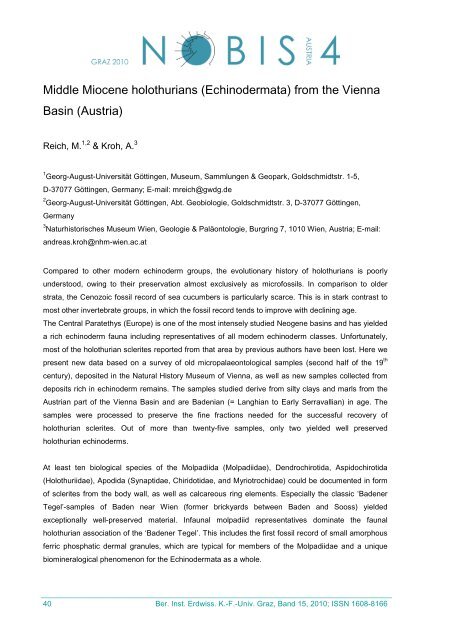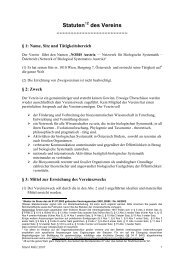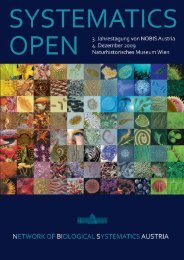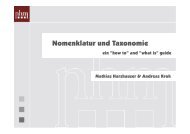4. Jahrestagung von NOBIS Austria 2. - 3. Dezember 2010
4. Jahrestagung von NOBIS Austria 2. - 3. Dezember 2010
4. Jahrestagung von NOBIS Austria 2. - 3. Dezember 2010
Create successful ePaper yourself
Turn your PDF publications into a flip-book with our unique Google optimized e-Paper software.
Middle Miocene holothurians (Echinodermata) from the Vienna<br />
Basin (<strong>Austria</strong>)<br />
Reich, M. 1,2 & Kroh, A. 3<br />
1 Georg-August-Universität Göttingen, Museum, Sammlungen & Geopark, Goldschmidtstr. 1-5,<br />
D-37077 Göttingen, Germany; E-mail: mreich@gwdg.de<br />
2 Georg-August-Universität Göttingen, Abt. Geobiologie, Goldschmidtstr. 3, D-37077 Göttingen,<br />
Germany<br />
3 Naturhistorisches Museum Wien, Geologie & Paläontologie, Burgring 7, 1010 Wien, <strong>Austria</strong>; E-mail:<br />
andreas.kroh@nhm-wien.ac.at<br />
Compared to other modern echinoderm groups, the evolutionary history of holothurians is poorly<br />
understood, owing to their preservation almost exclusively as microfossils. In comparison to older<br />
strata, the Cenozoic fossil record of sea cucumbers is particularly scarce. This is in stark contrast to<br />
most other invertebrate groups, in which the fossil record tends to improve with declining age.<br />
The Central Paratethys (Europe) is one of the most intensely studied Neogene basins and has yielded<br />
a rich echinoderm fauna including representatives of all modern echinoderm classes. Unfortunately,<br />
most of the holothurian sclerites reported from that area by previous authors have been lost. Here we<br />
present new data based on a survey of old micropalaeontological samples (second half of the 19 th<br />
century), deposited in the Natural History Museum of Vienna, as well as new samples collected from<br />
deposits rich in echinoderm remains. The samples studied derive from silty clays and marls from the<br />
<strong>Austria</strong>n part of the Vienna Basin and are Badenian (= Langhian to Early Serravallian) in age. The<br />
samples were processed to preserve the fine fractions needed for the successful recovery of<br />
holothurian sclerites. Out of more than twenty-five samples, only two yielded well preserved<br />
holothurian echinoderms.<br />
At least ten biological species of the Molpadiida (Molpadiidae), Dendrochirotida, Aspidochirotida<br />
(Holothuriidae), Apodida (Synaptidae, Chiridotidae, and Myriotrochidae) could be documented in form<br />
of sclerites from the body wall, as well as calcareous ring elements. Especially the classic ‘Badener<br />
Tegel’-samples of Baden near Wien (former brickyards between Baden and Sooss) yielded<br />
exceptionally well-preserved material. Infaunal molpadiid representatives dominate the faunal<br />
holothurian association of the ‘Badener Tegel’. This includes the first fossil record of small amorphous<br />
ferric phosphatic dermal granules, which are typical for members of the Molpadiidae and a unique<br />
biomineralogical phenomenon for the Echinodermata as a whole.<br />
_____________________________________________________________________________<br />
40 Ber. Inst. Erdwiss. K.-F.-Univ. Graz, Band 15, <strong>2010</strong>; ISSN 1608-8166






